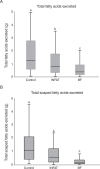SN2-Palmitate Reduces Fatty Acid Excretion in Chinese Formula-fed Infants
- PMID: 26334255
- PMCID: PMC4732008
- DOI: 10.1097/MPG.0000000000000971
SN2-Palmitate Reduces Fatty Acid Excretion in Chinese Formula-fed Infants
Abstract
Objectives: Palmitic acid (PA) comprises 17% to 25% of human milk fatty acids, of which 70% to 75% are esterified to the SN2 position of the triglyceride (SN2-palmitate). In vegetable oils, which are commonly used in infant formulas, palmitate is primarily esterified to other positions, resulting in reduced calcium and fat absorption and hard stools. The aim of this study was to elucidate the effects of SN2-palmitate on nutrient excretion.
Methods: In total, 171 Chinese infants were included (within 14 days of birth) in this multicenter study. Formula-fed infants were randomly assigned to receive either SN2-palmitate formula (INFAT, n = 57) or control formula (n = 57). The formulas (Biostime, China) differed only in their SN2 PA proportions. Stool was collected at 6 postnatal weeks.
Results: The stool dry weight and fat content of the SN2-palmitate group were lower compared with the control group (dry weight 4.25 g vs 7.28 g, P < 0.05; fat 0.8 g vs 1.2 g, P < 0.05). The lipid component was also significantly lower for the SN2-palmitate group (0.79 g vs 1.19 g, P < 0.05). PA, representing ∼50% of the saponified fatty acids, was significantly lower in the SN2-palmitate group compared with the control group (0.3 g vs 0.7 g, P < 0.01). Breast-fed infants had a significantly lower stool dry weight, fat content, and saponified fat excretion compared with formula-fed infants (P < 0.01).
Conclusions: Similar to breast milk, the SN2-palmitate infant formula primarily reduced calcium-saponified fat excretion. The results of this study further emphasize the nutritional importance of SN2-palmitate structured fat for infants.
Trial registration: ClinicalTrials.gov NCT01373541.
Conflict of interest statement
The authors report no conflicts of interest.
Figures



Similar articles
-
Effect of high β-palmitate content in infant formula on the intestinal microbiota of term infants.J Pediatr Gastroenterol Nutr. 2013 Apr;56(4):376-81. doi: 10.1097/MPG.0b013e31827e1ee2. J Pediatr Gastroenterol Nutr. 2013. PMID: 23201699 Clinical Trial.
-
Stool fatty acid soaps, stool consistency and gastrointestinal tolerance in term infants fed infant formulas containing high sn-2 palmitate with or without oligofructose: a double-blind, randomized clinical trial.Nutr J. 2014 Nov 5;13:105. doi: 10.1186/1475-2891-13-105. Nutr J. 2014. PMID: 25373935 Free PMC article. Clinical Trial.
-
Importance of the regiospecific distribution of long-chain saturated fatty acids on gut comfort, fat and calcium absorption in infants.Prostaglandins Leukot Essent Fatty Acids. 2017 Jun;121:40-51. doi: 10.1016/j.plefa.2017.05.007. Epub 2017 Jun 4. Prostaglandins Leukot Essent Fatty Acids. 2017. PMID: 28651696 Review.
-
Impact of an Infant Formula Containing a Novel Fat Blend (Cow's Milk Fat, Fish and Vegetable Oil) and Prebiotics on Stool Fatty Acid Soaps and Erythrocyte Fatty Acid Profiles in Full-Term Healthy Newborns.Ann Nutr Metab. 2021;77(3):138-145. doi: 10.1159/000515705. Epub 2021 Apr 30. Ann Nutr Metab. 2021. PMID: 33934094 Clinical Trial.
-
The influence of the position of palmitate in infant formula triacylglycerols on health outcomes.Nutr Res. 2017 Aug;44:1-8. doi: 10.1016/j.nutres.2017.05.009. Epub 2017 May 17. Nutr Res. 2017. PMID: 28821313 Review.
Cited by
-
An A2 β-casein infant formula with high sn-2 palmitate and casein phosphopeptides supports adequate growth, improved stool consistency, and bone strength in healthy, term Chinese infants: a randomized, double-blind, controlled clinical trial.Front Nutr. 2024 Aug 14;11:1442584. doi: 10.3389/fnut.2024.1442584. eCollection 2024. Front Nutr. 2024. PMID: 39206307 Free PMC article.
-
The Role of Dietary Fats in the Development and Prevention of Necrotizing Enterocolitis.Nutrients. 2021 Dec 29;14(1):145. doi: 10.3390/nu14010145. Nutrients. 2021. PMID: 35011027 Free PMC article. Review.
-
Infant Formula with 50% or More of Palmitic Acid Bound to the sn-2 Position of Triacylglycerols Eliminate the Association between Formula-Feeding and the Increase of Fecal Palmitic Acid Levels in Newborns: An Exploratory Study.Nutrients. 2024 May 21;16(11):1558. doi: 10.3390/nu16111558. Nutrients. 2024. PMID: 38892492 Free PMC article.
-
High versus low medium chain triglyceride content of formula for promoting short-term growth of preterm infants.Cochrane Database Syst Rev. 2021 Feb 23;2(2):CD002777. doi: 10.1002/14651858.CD002777.pub2. Cochrane Database Syst Rev. 2021. PMID: 33620090 Free PMC article.
-
Profiles of total and sn-2 fatty acid of human mature milk and their correlated factors: A cross-sectional study in China.Front Nutr. 2022 Aug 22;9:926429. doi: 10.3389/fnut.2022.926429. eCollection 2022. Front Nutr. 2022. PMID: 36071934 Free PMC article.
References
-
- Agostoni C, Braegger C, Decsi T, et al. Breast-feeding: a commentary by the ESPGHAN Committee on Nutrition. J Pediatr Gastroenterol Nutr 2009; 49:112–125. - PubMed
-
- Giovannini M, Riva E, Agostoni C. Fatty acids in pediatric nutrition. Pediatr Clin North Am 1995; 42:861–877. - PubMed
-
- Breckenridge WC, Marai L, Kuksis A. Triglyceride structure of human milk fat. Can J Biochem 1969; 47:761–769. - PubMed
-
- Mu H, Hoy CE. The digestion of dietary triacylglycerols. Prog Lipid Res 2004; 43:105–133. - PubMed
Publication types
MeSH terms
Substances
Associated data
LinkOut - more resources
Full Text Sources
Other Literature Sources
Medical

